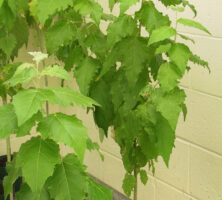Many types of soil and water pollutants that pose a serious risk to human and environmental health can be removed through a process known as phytoremediation. Phytoremediation is a type of bioremediation (the removal of toxins from the environment using microorganisms) in which plants are used to break down and remove unwanted or dangerous toxins and contaminants that might otherwise persist in the environment for hundreds or thousands of years.

Photograph by Sarah E. McKee, New Georgia Encyclopedia
Soil and water can become contaminated through pesticide use, oil and chemical spills, and improper disposal of chemicals and industrial waste. Additionally, many chemicals can seep into groundwater and spread great distances from the original site of contamination. These contaminants are often harmful to humans and other life forms, as they can cause cancer, blindness, loss of organ function, severe illness, and death.
Traditional cleanup of contaminated soil is expensive and difficult because it usually involves the physical removal of all toxic soil from the site. The soil is then cleaned in a factory and returned to the site, or new soil is brought in to replace the old. This arduous process has led scientists to seek a more economical and natural method of cleanup that does not involve the removal and replacement of soil.
The bioengineered techniques of phytoremediation offer cleanup solutions that can be applied to large areas and are less expensive and less destructive to the environment than conventional physical removal methods. While bioremediation involves placing specific kinds of bacteria or fungi directly into the soil or water, phytoremediation (“phyto” is derived from the Greek word for “plant”) involves transferring specific genetic traits found in bacteria and fungi directly into trees or other plants. The genetically altered plants are then placed in the soil or water, where they take up specific contaminants and either store them or transform them into less harmful forms.
How Phytoremediation Works
Some bacteria and fungi contain genetic material that gives them a natural ability to convert certain harmful chemicals and metals into less dangerous forms. Researchers can remove this specific genetic material from the microorganisms, produce copies of the material through the cloning process, and then insert those copies into the deoxyribonucleic acid (commonly known as DNA, the genetic material in a cell’s nucleus) of a target plant. The resulting transgenic (genetically modified) plants will then contain genetic material that enables them to take up pollutants from soil or water and store those pollutants in their above-ground structures, such as stems and leaves. Once a contaminated site has been sufficiently remediated, the plants can be harvested and removed, along with any pollutants stored within them.
Transgenic plants can be designed to clean up specific toxins, depending upon the type of pollutant present at the site. For organic pollutants, or those that contain carbon, plants can be engineered either to degrade the compound themselves or to provide nutrients and support to the microorganisms that do the work. Inorganic pollutants, which consist mainly of metals, can be absorbed from soil or water and then stored within the plant.
Methods of phytoremediation fall into four main categories: accumulation, phytodegradation, enhanced rhizosphere biodegradation, and physical effects. Accumulation refers to how certain plant activities allow plants to store pollutants without harming themselves. This is a common function among phytoremediation plants, and the class of plants called hyperaccumulators, which can safely uptake high concentrations of pollutants, is quite useful. Phytodegradation is the breakdown of a contaminant by a plant into less toxic forms. Enhanced rhizosphere biodegradation refers to the helper effects that plant roots can have on the microbial population in the immediate area. Physical effects include many different processes, but especially important are plants’ influences on the movements of contaminants through groundwater. Plants that consume significant amounts of water can help keep contaminated water supplies from spreading.
Phytoremediation in Georgia
Because of its potential usefulness, phytoremediation has been the subject of much research. The genetics and forestry departments at the University of Georgia (UGA) in Athens are working together to develop plants that can clean up soils contaminated with such metals as mercury and arsenic. People suffering from mercury or arsenic poisoning may experience nausea, vomiting, pain, altered states of mind, or be at increased risk of developing several forms of cancer, so this area of research has many potential benefits for human health. As of 2009 researchers at UGA had succeeded in making eastern cottonwood (Populus deltoides), yellow poplar (Liriodendron tulipifera), and sweetgum (Liquidambar styraciflua) trees capable of growing in mercury-contaminated soils. These trees convert the mercury into forms that are less harmful to humans, animals, or other plants.
The U.S. Environmental Protection Agency (EPA) uses phytoremediation to help clean some of its “Superfund” sites, which are sites contaminated with many types of hazardous chemicals and metals. The federal Comprehensive Environmental Response, Compensation, and Liability Act (CERCLA) was passed in 1980 and requires EPA to ensure that these sites are cleaned in order to protect humans and the environment. As of 2009 Georgia had fifteen actively listed Superfund sites. At least one of these, the LCP Chemicals site in Brunswick, uses phytoremediation to aid in cleanup.






